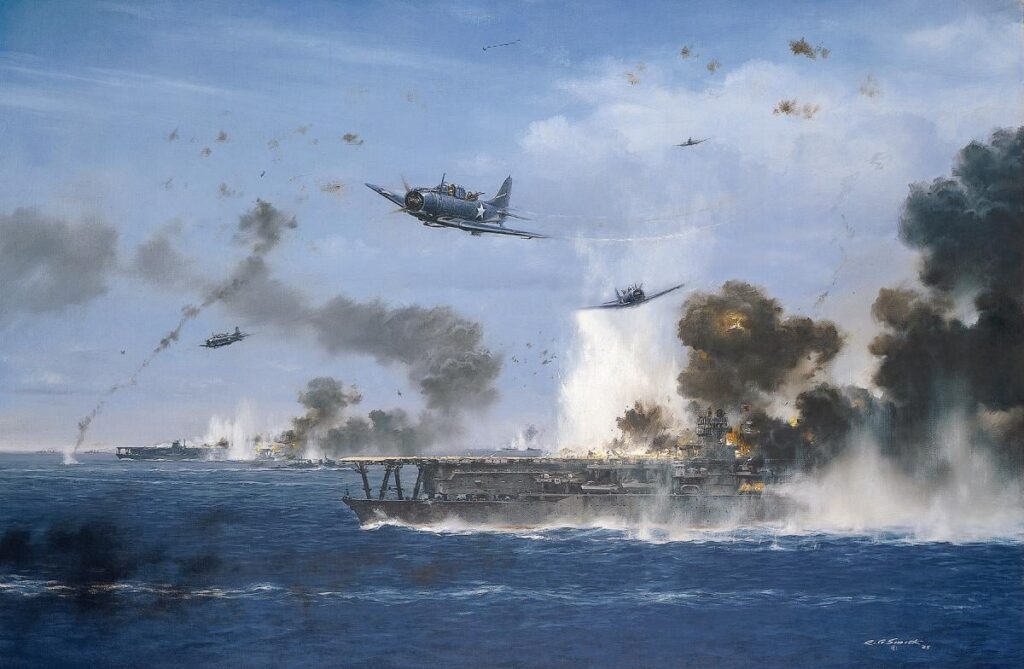The Battle of Midway, fought in June 1942, was a crucial turning point in World War II. This battle marked a significant defeat for the Imperial Japanese Navy and a strategic victory for the United States. The United States’ success in breaking Japanese naval codes and effectively countering the attack on Midway Island demonstrated the importance of intelligence and air power in modern warfare. The battle also cemented the strategy of “island-hopping” for Pacific theater operations and showcased the effectiveness of carrier-based warfare. The victory at Midway boosted American morale and shifted the balance of power in the Pacific, making it one of the most significant naval battles in history.
The Battle of Midway: A Turning Point in Naval Strategy
Introduction
The Battle of Midway, fought between June 4th and 7th, 1942, was a crucial naval battle in the Pacific theater during World War II. This battle marked a turning point in the war, as it resulted in a significant defeat for the Imperial Japanese Navy and a strategic victory for the United States Navy. The outcome of the Battle of Midway had far-reaching implications for naval strategy and the eventual outcome of the war.
Background
After the Japanese attack on Pearl Harbor on December 7th, 1941, the United States found itself at war with Japan. The Japanese quickly advanced through the Pacific, capturing a number of key islands and establishing a defensive perimeter that included Midway Island. The Japanese planned to expand their territory and draw the remaining United States Pacific Fleet into a decisive battle to eliminate it as a strategic threat. However, the United States had broken the Japanese naval codes and were aware of the Japanese plan to attack Midway Island.
The Battle
The Battle of Midway began on June 4th, 1942, when a Japanese strike force launched an attack on Midway Island. The United States Navy, aware of the Japanese plan, was prepared and launched a series of counterattacks. The crucial turning point came when American dive bombers sank four Japanese aircraft carriers, crippling the Japanese fleet and shifting the balance of power in the Pacific. The battle lasted four days, and the United States emerged victorious, inflicting heavy losses on the Japanese Navy.
Impact
The Battle of Midway had a significant impact on naval strategy and the course of the war. The defeat at Midway was a severe blow to the Japanese Navy, as it lost four of its aircraft carriers and a substantial number of trained pilots. This loss severely weakened the Japanese naval power and marked a turning point in the Pacific War, shifting the strategic initiative to the United States.
For the United States, the victory at Midway provided a much-needed boost to morale and demonstrated the effectiveness of its naval and intelligence capabilities. The battle also marked the first major defeat for the Japanese Navy, taking away its aura of invincibility and setting the stage for further Allied advances in the Pacific.
Naval Strategy
The Battle of Midway also had a lasting impact on naval strategy. The successful use of intelligence gathering and code-breaking by the United States demonstrated the importance of these factors in modern warfare. The battle highlighted the effectiveness of aircraft carriers and air power in naval engagements, leading to a shift in naval doctrine towards carrier-based warfare.
Moreover, the Battle of Midway cemented the concept of “island-hopping” as a strategy for Pacific theater operations. This involved capturing and securing strategically located islands as bases for further advancement towards the Japanese mainland. The battle demonstrated the importance of securing key bases and denying them to the enemy, which became a central tenet of Allied wartime strategy in the Pacific.
Conclusion
The Battle of Midway was a pivotal moment in World War II, marking a turning point in naval strategy and the eventual outcome of the war in the Pacific. The victory at Midway boosted American morale, shifted the strategic initiative to the United States, and demonstrated the importance of carrier-based warfare and intelligence in modern naval operations. The battle’s impact on naval strategy influenced future military doctrines and shaped the course of the Pacific War, making it one of the most significant naval battles in history.
